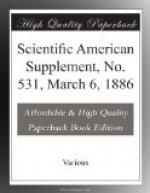The coming metal, then, to which our reference is made is aluminum, the most abundant metal in the earth’s crust. Of all substances, oxygen is the most abundant, constituting about one-half; after oxygen comes silicon, constituting about one-fourth, with aluminum third in all the list of substances of the composition. Leaving out of consideration the constituents of the earth’s center, whether they be molten or gaseous, more or less dense as the case may be, as we approach it, and confining ourselves to the only practical phase of the subject, the crust, we find that aluminum is beyond question the most abundant and the most useful of all metallic substances.
It is the metallic base of mica, feldspar, slate, and clay. Professor Dana says: “Nearly all the rocks except limestones and many sandstones are literally ore-beds of the metal aluminum.” It appears in the gem, assuming a blue in the sapphire, green in the emerald, yellow in the topaz, red in the ruby, brown in the emery, and so on to the white, gray, blue, and black of the slates and clays. It has been dubbed “clay metal” and “silver made from clay;” also when mixed with any considerable quantity of carbon becoming a grayish or bluish black “alum slate.”
This metal in color is white and next in luster to silver. It has never been found in a pure state, but is known to exist in combination with nearly two hundred different minerals. Corundum and pure emery are ores that are very rich in aluminum, containing about fifty-four per cent. The specific gravity is but two and one-half times that of water; it is lighter than glass or as light as chalk, being only one-third the weight of iron and one-fourth the weight of silver; it is as malleable as gold, tenacious as iron, and harder than steel, being next the diamond. Thus it is capable of the widest variety of uses, being soft when ductility, fibrous when tenacity, and crystalline when hardness is required. Its variety of transformations is something wonderful. Meeting iron, or even iron at its best in the form of steel, in the same field, it easily vanquishes it at every point. It melts at 1,300 degrees F., or at least 600 degrees below the melting point of iron, and it neither oxidizes in the atmosphere nor tarnishes in contact with gases. The enumeration of the properties of aluminum is as enchanting as the scenes of a fairy tale.
Before proceeding further with this new wonder of science, which is already knocking at our doors, a brief sketch of its birth and development may be fittingly introduced. The celebrated French chemist Lavoisier, a very magician in the science, groping in the dark of the last century, evolved the chemical theory of combustion—the existence of a “highly respirable gas,” oxygen, and the presence of metallic bases in earths and alkalies. With the latter subject we have only to do at the present moment. The metallic base was predicted, yet not identified. The French Revolution swept this genius from the earth




